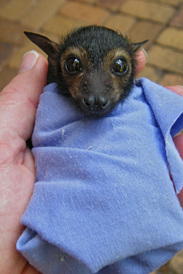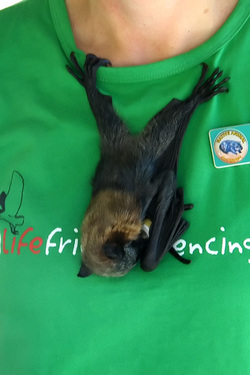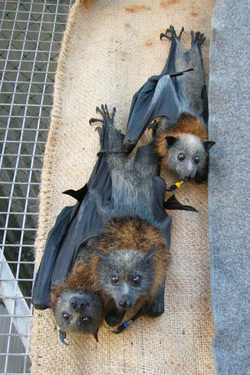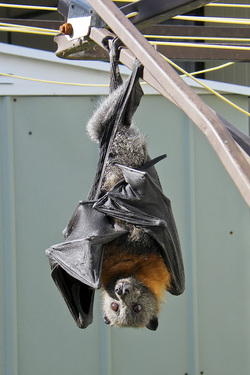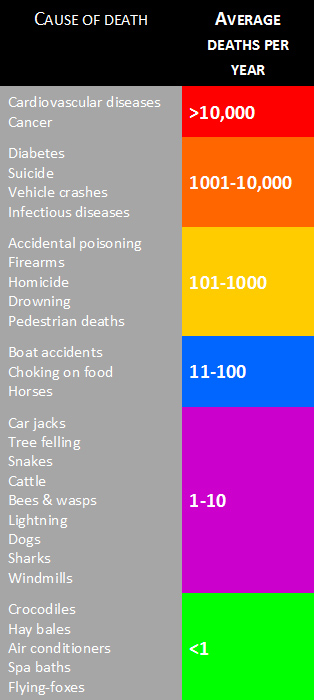Bats and Human Health
Are flying-foxes a health risk?In a speech to Parliament in August 2011, Andrew Powell said urban bat colonies represented a significant threat to human health. A calm analysis of the facts shows that the health associated with flying-foxes is less than that posed by domestic pets, including birds, dogs and cats, and medical experts say that urban bat camps are not a health risk.
See further information on the list below at Qld Health. In a Lyssavirus Fact Sheet (also from Qld Health) authorities say "contact or exposure to bat faeces, urine or blood do not pose a risk of exposure to ABLV, nor do living, playing or walking near bat roosting areas". Most claims about health risks are untrue
How do bats rate as a threat?Those who advocate protecting flying-foxes include wildlife carers, researchers or conservationists who have very close, regular contact with flying-foxes (see photos left). Many of these people regularly handle wild flying foxes. If anyone is at risk, they are. But they know that the risk of catching disease from bats is extremely low, and that measures can be taken to keep safe. After all, just one Australian is known to have become ill and died due to an encounter with a flying-fox, in 1998, from Australian bat lyssavirus, although the tragic death of a young Queensland boy in 2013 may have been been transmitted by a flying fox (health authorities have not divulged the source).
The table (above) ranks various causes of death, showing that flying-foxes are less of a risk than horses, cattle, bees, hay bales, windmills, air conditioners, car jacks and more than a dozen better known killers. Flying-foxes are safer than virtually everything else you encounter in an urban environment (just don’t touch them)! See here, here and here for more information. The people shown in these images are trained, licensed, vaccinated wildlife rehabilitators - you should not handle wildlife for your own safety, as well as the welfare of the animal: rather, call your local wildlife rescue group (see here for contacts). |
REFERENCES:References for the table can be found here. Major sources of data are:
(1) Australian Bureau of Statistics, Causes of Death, Australia (annual data available for the period 1990-2009 on the ABS website);
(2) Australian Bureau of Statistics, Year Book Australia, (annual data available for 1990-2009 on the ABS website). See http://www.abs.gov.au/
(3) National Coroners Information Service report into Deaths Involving Animals, May 2006. See www.ncis.org.au/web_pages/Broadsheet2_Animal%20related.pdf.
(4) National Coroners Information System. 2007. A sample of consumer product related deaths. Deaths reported from 01/07/2000–30/06/2007. See www.ncis.org.au/Product%20related%20fatalities%20national%20version.pdf.
(5) Pollock K, Fragar L, Morton C. 2007. Traumatic deaths in Australian agriculture – The facts. Rural Industries Research and Development Corporation and Australian Centre for Agricultural Health and Safety
(6) Franklin R, Mitchell R, Driscoll T, Fragar L. 2000. Farm-related fatalities in Australia, 1989-1992. Moree: ACAHS, NOHSC & RIRDC
All images on this page courtesy Steve Amesbury - Australian Fauna Care
(1) Australian Bureau of Statistics, Causes of Death, Australia (annual data available for the period 1990-2009 on the ABS website);
(2) Australian Bureau of Statistics, Year Book Australia, (annual data available for 1990-2009 on the ABS website). See http://www.abs.gov.au/
(3) National Coroners Information Service report into Deaths Involving Animals, May 2006. See www.ncis.org.au/web_pages/Broadsheet2_Animal%20related.pdf.
(4) National Coroners Information System. 2007. A sample of consumer product related deaths. Deaths reported from 01/07/2000–30/06/2007. See www.ncis.org.au/Product%20related%20fatalities%20national%20version.pdf.
(5) Pollock K, Fragar L, Morton C. 2007. Traumatic deaths in Australian agriculture – The facts. Rural Industries Research and Development Corporation and Australian Centre for Agricultural Health and Safety
(6) Franklin R, Mitchell R, Driscoll T, Fragar L. 2000. Farm-related fatalities in Australia, 1989-1992. Moree: ACAHS, NOHSC & RIRDC
All images on this page courtesy Steve Amesbury - Australian Fauna Care
